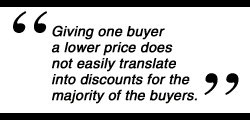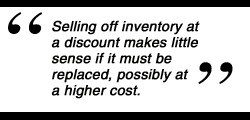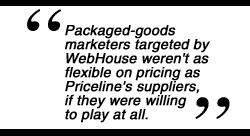WebHouse Rocked: Why Priceline's Groceries and Gasoline Venture Failed
The short self life of Priceline's WebHouse shows some products aren't suited to dynamic pricing. But it doesn't mean the model can't work.
It seemed like a good idea at the time. Priceline.com Inc. had already successfully developed its name-your-own-price technology to lure bargain-conscious travelers searching for cheap airline tickets and hotel rooms — the first major Web-based foray into so-called dynamic pricing. Why not go after the rest of the consumer marketplace, starting with necessities like groceries and gasoline?
Thus, Priceline's first progeny, WebHouse Club Inc., was born in November 1999. Less than a year later, in October 2000, WebHouse had run out of gas, groceries, and money. And with as much fanfare as it arrived, WebHouse folded — one more in a series of e-business failures that have littered the latter half of Y2K.
Why did Priceline's pricing scheme work for one set of products but not the other? With Internet shopping and the application of dynamic pricing models in their infancy, the answers are important for all retailers with Web aspirations.

First, there's the nature of the products' sales cycle. There's an incentive for an airline or hotel to sell off unfilled seats or rooms at the last minute, because they're "perishable." That is, if a seat on a particular flight isn't filled, or a hotel room on a particular night isn't used, the opportunity to sell them at any price is lost forever. You can't put them in inventory until you find a customer. Consumer packaged goods and gasoline — the products offered by WebHouse — have no such limitation.
Second, selling off inventory at a discount makes little sense if it must be replaced, possibly at a higher cost. Because airline and hotel operating costs are fixed filling a seat or a bed uses capacity that is already paid for. Therefore, the cost of adding a customer is negligible. While there isn't the same pressure to move inventory as there is with physical goods, there is greater pricing flexibility. In a pinch, almost any sale price would represent a profit. In contrast, with groceries, there are costs for each unit related to manufacturing, processing, shipping, and maintaining inventory that must be covered.
Third, there's a difference between commodity products and branded goods — at least from the producer's vantage point. For airline tickets and hotel rooms, Priceline wants customers whose primary concern is price. For them the product is a commodity. They want a flight to where they want to go at a price they can afford. They don't care about the name of the carrier or if they have to fly a circuitous route. And the airlines and hospitality companies, for all their lip service to the importance of branding, also treat their goods and services largely as commodities, with a wide range of prices that vary according to supply and demand at a given moment. For them, Priceline is just an extension of their existing yield management systems.

But WebHouse depended on the participation of brand-name packaged-goods manufacturers, which viewed this sort of permanent discounting as a dangerous liability for their brands. While manufacturers selectively use discount coupons to attract new customers based on price, the goal is to win their repeat business and brand loyalty, allowing the manufacturers to step out of the game of continual underbidding. So the target packaged-goods marketers for WebHouse weren't as flexible on pricing as Priceline's suppliers, if they were willing to play at all. "We're trying to make connections with consumers and not market our products based on price," a spokesperson for the Kimberly-Clark Corporation told The Wall Street Journal. "We never participated with Priceline despite lots of overtures from the company." With such resistance from manufacturers there was little hope WebHouse could work, despite the company's insistence that it was the funding drought that brought them down.
Fourth, giving one buyer a lower price does not easily translate into providing discounts to the majority of buyers. Airlines can offer a lower fare to one customer who is willing to make last-minute travel plans, without cutting prices to others who want confirmed seats well in advance of their travel dates.
There is little flexibility to charge different customers different prices for manufactured items. You can sell day-old bread at a discount, but there's no such thing as day-old gasoline or week-old laundry detergent. Differentiating products on short notice in other ways, such as design or function, would be cumbersome and prohibitively expensive.
Old Story, New Twist
Dynamic pricing has been with us since the first farmer haggled with a customer over the price of grain in a village market. Although the economics of haggling went out with industrialization, many believe the real-time interactive capabilities of the Web have the potential to revive it.

Still, not all consumers will look on this favorably. Witness the recent uproar over Amazon's experiment in charging different customers different amounts for the same products. Or the controversy generated when former Coca-Cola Chief Executive Douglas Ivester mused about the possibility of Coke machines that could automatically increase prices during hot weather. There are clearly cultural variables, like the American spirit of fair play, which could complicate some initiatives.
In general, however, we believe the future of dynamic pricing is positive. To assess the appropriateness of a given model, we recommend a few criteria as a basic litmus test.
- Information has to be an important component of the product or service. The Web can't compress physical labor and other fixed costs; all it can do is make marketing and other information-intensive processes more efficient. That efficiency must be large enough to leave room for haggling.
- There must be benefits for both buyers and sellers to change the way they do business. Self-interest has to be part of the system.
- Middlemen will stay in business as long as they can provide benefits to both sides. At a minimum they must provide a forum to match the right buyer with the right seller (like eBay Inc.), and make a profit. If, as with Webhouse, they can only add value by burning investor cash to deliver a benefit to one participant in the transaction, they can't succeed.
| Authors
Raman Muralidharan, muralidharan_raman@bah.com Raman Muralidharan is a Cleveland-based vice president in Booz-Allen & Hamilton’s Consumer and Health Practice. He is a strategist focused on growth for companies in technology- intensive industries, particularly those firms trying to commercialize new game-changing technologies and/or build new business models. Rhonda Germany, germany_rhonda@bah.com Rhonda Germany is a vice president in Booz-Allen & Hamilton’s Consumer and Health Practice and leads the firm’s U.S. e-Business Core Team. Ms. Germany is a strategist focused on corporate and business-unit strategy for companies in technology- intensive industries, particularly those firms facing significant shifts in their value chains. |



